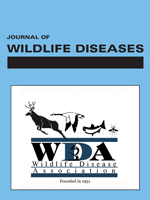Lungs of 102 roe deer (Capreolus capreolus), 136 moose (Alces alces), 68 fallow deer (Dama dama), and six red deer (Cervus elaphus) were examined during hunting seasons from 16 September 1997 to 1 March 2000. The aim was to determine the species composition and prevalence of Dictyocaulus lungworms in these hosts in Sweden. Worms were identified following polymerase chain reaction (PCR) amplification of the internal transcribed spacer of ribosomal DNA (ITS2), followed by hybridization with four species-specific oligonucleotides. In addition, 50 lungworms from five reindeer (Rangifer tarandus) from Norway were similarly analyzed. A total of 399 worms were recovered and analyzed representing a range of 29–128 worms per host species. All specimens from roe deer were identified as Dictyocaulus capreolus, whereas those from red deer and reindeer were identical with D. eckerti. From moose, 73 (81.1%) of the worms were identified as D. capreolus whereas 17 (18.9%) were D. eckerti. The ITS2 sequence of fallow deer lungworms differed significantly when compared with the ITS2 of D. viviparus, D. capreolus, and D. eckerti. This indicated that fallow deer in Sweden may be infected with a new genotype of Dictyocaulus spp. Consequently, a specific probe designed for the ITS2 from this Dictyocaulus sp. hybridized exclusively with samples from lungworms of fallow deer. Interestingly, no D. viviparus were found in any of these hosts. The prevalence of infection in each host was as follows: D. capreolus in roe deer (14.7%) and moose (10.6%); D. eckerti in moose (0.7%) and red deer (33.3%); and Dictyocaulus sp. in fallow deer (10.3%). Regardless of lungworm species, the overall prevalence of Dictyocaulus spp. in these hosts was 12.2%. Prevalence between male and female animals and among the different age groups did not differ significantly. Finally an enzyme linked immunosorbent assay (ELISA) specific for patent D. viviparus infection in cattle was utilized to analyze lung tissue fluids from infected animals. All samples from roe deer, red deer, and fallow deer were negative in the ELISA. However, three out of twelve (25%) samples from moose and 17 of 40 (43%) samples from cattle were positive. This indicated that moose anti-D. capreolus antibodies recognized the D. viviparus antigen and that anti-cattle immunoglobulin cross-reacted with moose antibodies.
How to translate text using browser tools
1 October 2002
MOLECULAR IDENTIFICATION AND PREVALENCE OF DICTYOCAULUS SPP. (TRICHOSTRONGYLOIDEA: DICTYOCAULIDAE) IN SWEDISH SEMI-DOMESTIC AND FREE-LIVING CERVIDS
Billy P. Divina,
Elisabeth Wilhelmsson,
Torsten Mörner,
Jens G. Mattsson,
Johan Höglund

Journal of Wildlife Diseases
Vol. 38 • No. 4
October 2002
Vol. 38 • No. 4
October 2002
cervids
Dictyocaulus spp.
ELISA
ITS2
lungworms
molecular identification
Sweden




